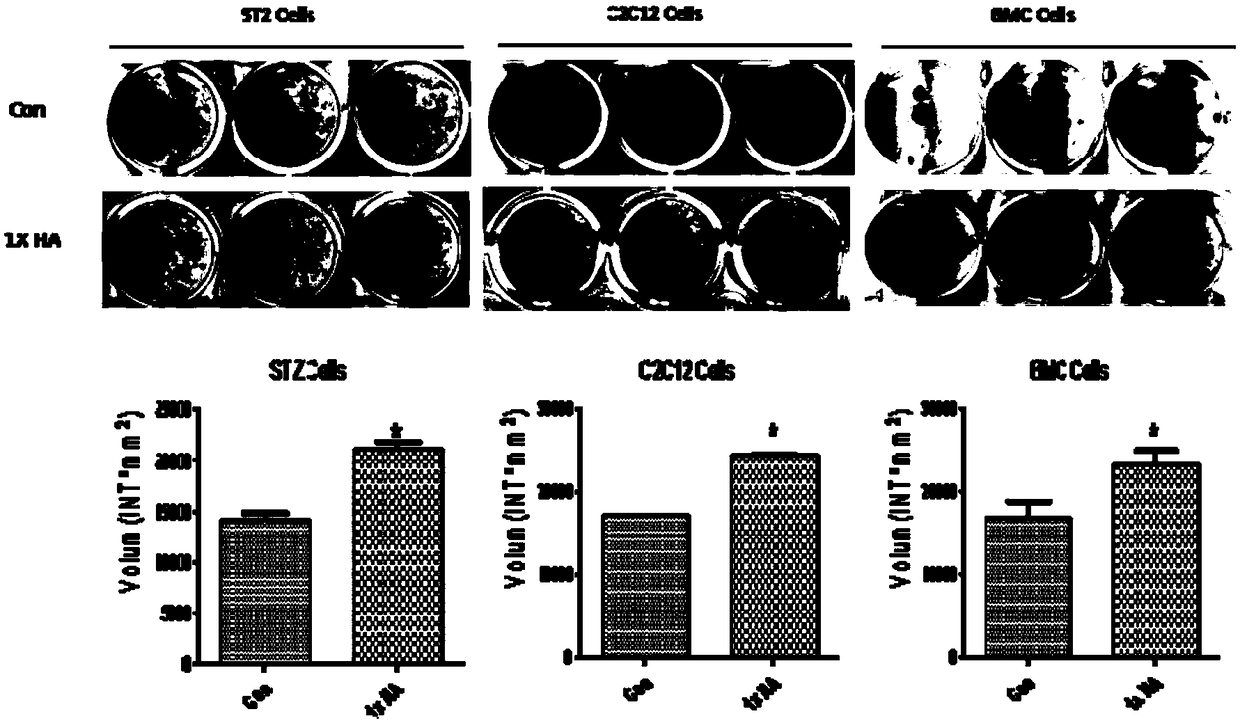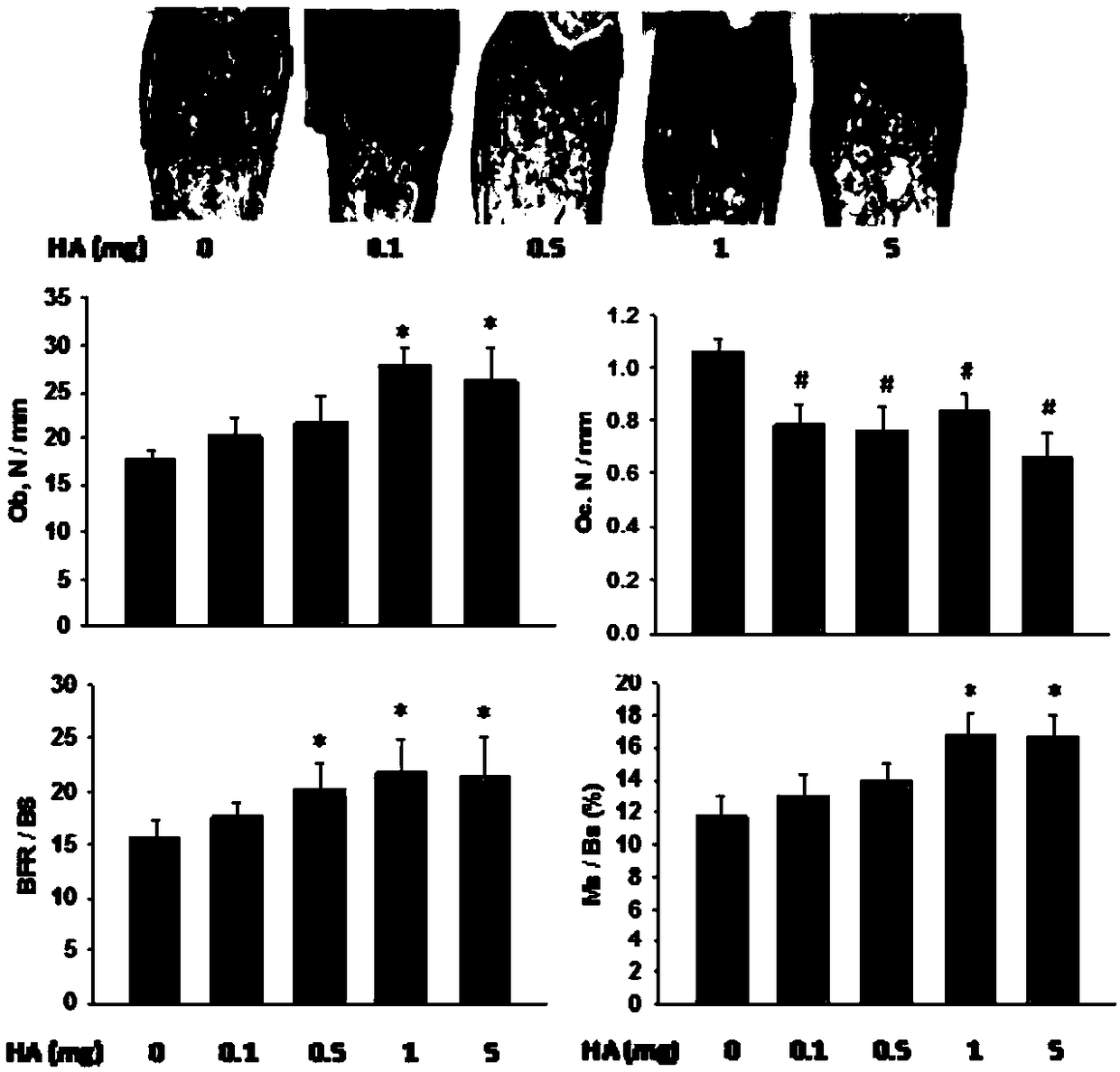Application of hippuric acid in preparing osteoporosis resistant drug
A technology for benzoylglycine and osteoporosis, which is applied to the application field of benzoylglycine active small molecules in the preparation of anti-osteoporosis drugs, and can solve the problems of unclear biological activity, low benzoylglycine, etc. , to increase the number of osteoblasts, increase bone mass, and reduce the number of osteoclasts
- Summary
- Abstract
- Description
- Claims
- Application Information
AI Technical Summary
Problems solved by technology
Method used
Image
Examples
Embodiment 1
[0027] Bone marrow ST2 stromal cells (ST2Cells), bipotential preosteoblasts (C2C12Cells), primary mouse bone marrow stromal cells (BMC Cells) were supplemented with 10% fetal bovine serum (FBS), penicillin (100 units / ml), strepto Mycin (100 μg / ml) and glutamine (4 mM) were cultured on α-MEM medium. They were then incubated with benzoylglycine at a final concentration of 60 μg / dl (1× concentration) for 12 days, and the solvent was used as a control (n=3). Use bone-specific alkaline phosphatase (ALP) staining, and then detect cell changes under a microscope, the results are as follows figure 1 Shown (data are expressed as mean ± SEM (n = 3 / group). Compared with the control group, t test was used, and significant differences are indicated by * (pfigure 1 The results showed that HA significantly promoted the proliferation and differentiation of osteoblasts.
Embodiment 2
[0029] Pre-adipocyte 3T3L1 cells (3T3L1Cells) were cultured using the same method, and then incubated with benzoylglycine at different concentrations of 30 μg / dl (0.5x), 60 μg / dl (1x), and 120 μg / dl (2x) for 3 days, and the solvent was used as a control (n=3). (Data are expressed as mean ± SEM (n=3 / group). Compared with the control group, t-test was used, and significant differences were indicated by * (p figure 2 It shows that benzoylglycine can inhibit the proliferation of adipocytes in a concentration-dependent manner (2A), and promote the differentiation of adipocytes into osteoblast-like cells (2B) (10x and 20x tables represent magnifications).
Embodiment 3
[0031] Female C57BL / 6J mice were purchased from Jackson Laboratory (Bar Harbor, Me, USA). These postnatal day (PND) 25 mice were randomly assigned to 5 groups (n=5). All five groups of mice received an AIN-93G diet formulated with casein as the sole protein source throughout the experiment. The control group was intraperitoneally injected with normal saline every day, and the other four groups were injected with HA at a dose of 0.1, 0.5, 1 or 5 mg / kg / day, named as the four HA test groups of 0.1, 0.5, 1, and 5, respectively. All groups of mice were fed in pairs, and the food and caloric intake in the five groups were strictly controlled. The mice were kept under the conditions established by the Animal Evaluation and Accreditation Committee of the Arkansas Children's Hospital Research Center, with constant humidity, a temperature of 22°C, and light hours from 6:00 am to 6:00 pm. All animal experimental procedures were approved by the Arkansas Medical College Animal Care and U...
PUM
 Login to View More
Login to View More Abstract
Description
Claims
Application Information
 Login to View More
Login to View More - R&D
- Intellectual Property
- Life Sciences
- Materials
- Tech Scout
- Unparalleled Data Quality
- Higher Quality Content
- 60% Fewer Hallucinations
Browse by: Latest US Patents, China's latest patents, Technical Efficacy Thesaurus, Application Domain, Technology Topic, Popular Technical Reports.
© 2025 PatSnap. All rights reserved.Legal|Privacy policy|Modern Slavery Act Transparency Statement|Sitemap|About US| Contact US: help@patsnap.com



